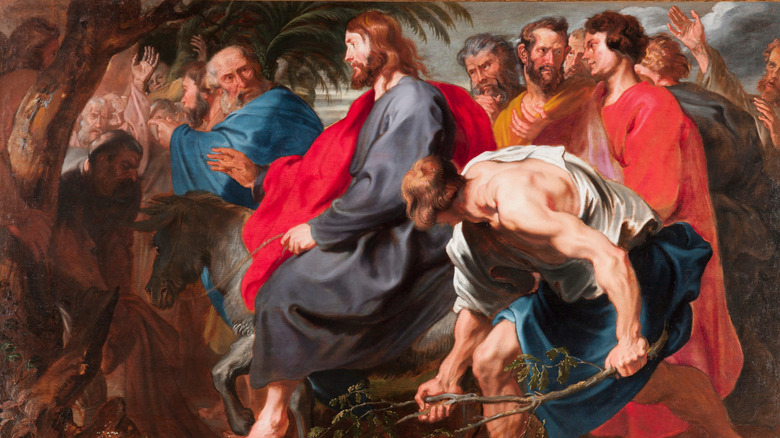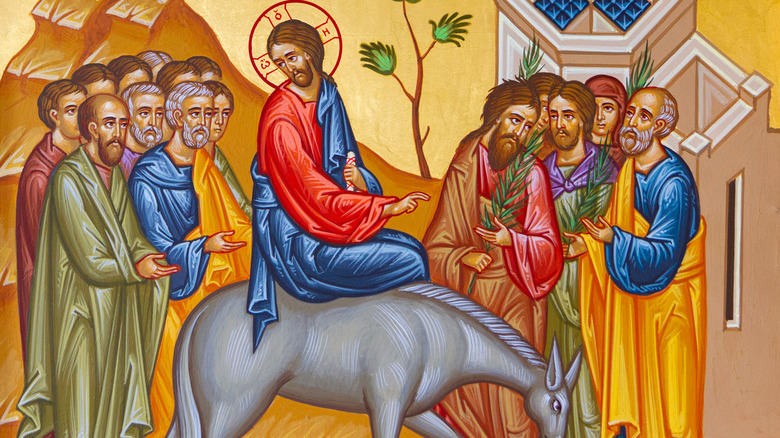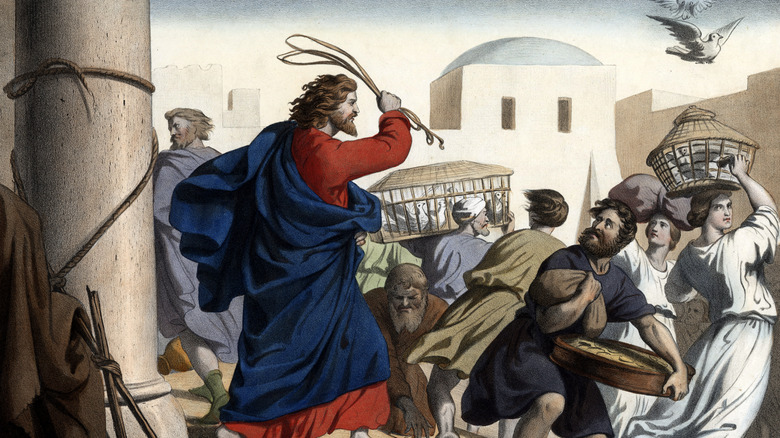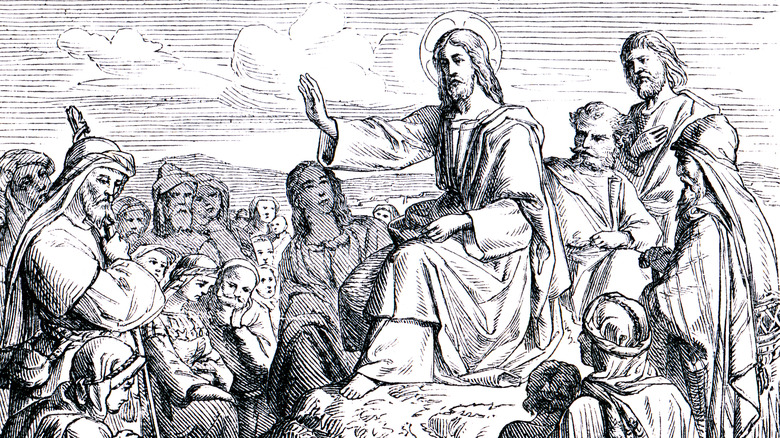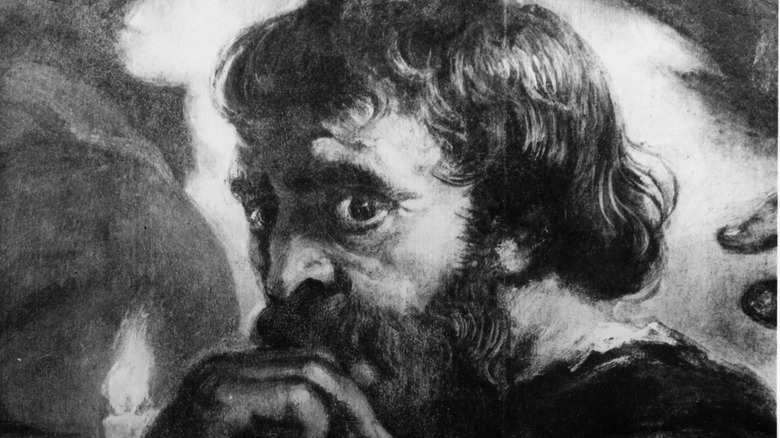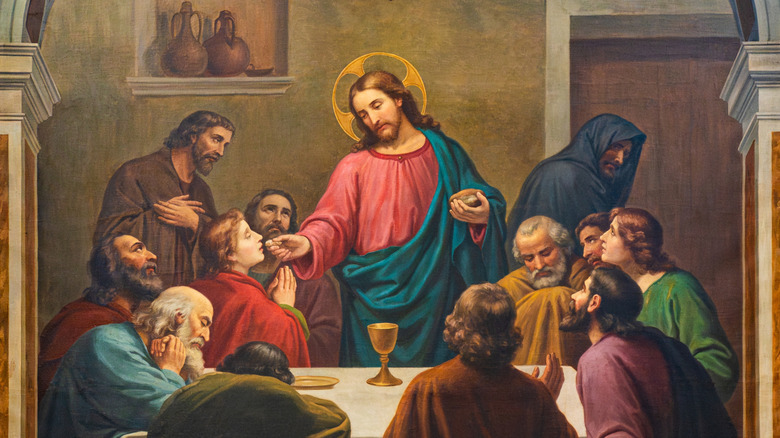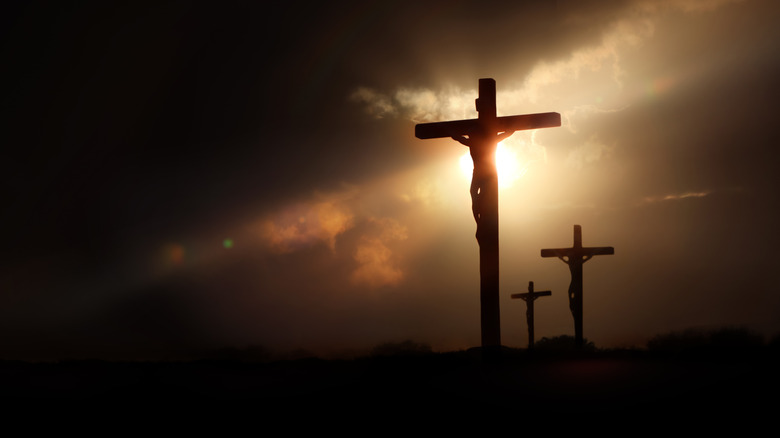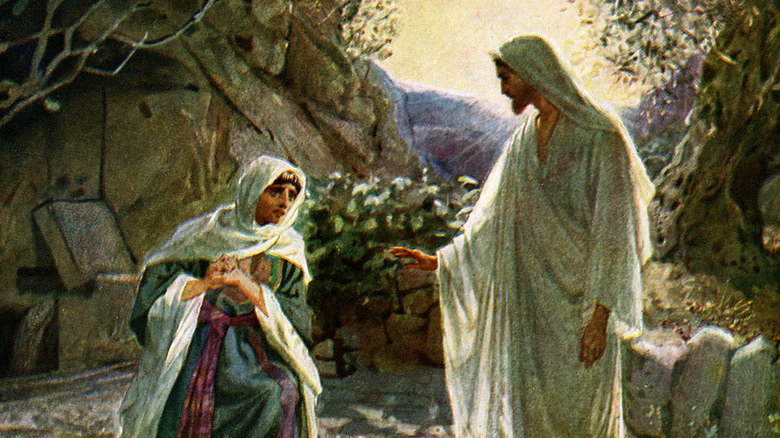Holy Week Timeline Explained
If there's one period of time that's central to Christianity, surely it's the eight-day period known as Holy Week. Christmas may celebrate the birth of Jesus Christ (which may not have actually happened in late December), but the entire religion hinges on the events of his final week on Earth, beginning with what many now call Palm Sunday and ending with his triumphant return from seeming death on Easter (Resurrection Sunday).
Prior to Holy Week, Jesus had already established himself as a religious figure, though his actual ministry appears to have taken place over just three or so years. Getting an exact timeline is tricky, as the Gospels that mean to relate his story sometimes speed through his earlier years (in fact, the Gospel of John skips it almost entirely). But it was reportedly packed full of miracles and meaningful speeches that drew more and more followers, and must have threatened to destabilize the existing religious and political order of the time.
Certainly, by the time Jesus entered Jerusalem on Palm Sunday, he was attracting the attention of both devoted followers and unnerved officials. Poised as both a possible messiah and an insurrectionist (depending on who you asked), the next few days would prove to be pivotal not just to Jesus and his disciples, but for a major new religion that had not yet debuted.
Palm Sunday: Jesus makes a splash entering Jerusalem
Holy Week started with a grand entrance of Jesus into the city of Jerusalem. In Matthew 21:1-11, Jesus told his disciples to find a donkey and its offspring in a nearby village. When they brought the animals to him, Jesus sat on the donkey and rode it into the city. The tale is similar in Mark 11:1-11, Luke 19-28-44, and John 12:12-19.
Crowds proclaimed that he was the long-awaited messiah, or a religious King of Israel (a title that would have had authorities feeling mightily threatened). The people were said to have come bearing tree branches or, in the case of John's account, the palm branches that give Palm Sunday its name and often feature in celebrations today. The accounts in Matthew, Mark, and Luke also allege that people placed their clothes in Jesus' path to create a sort of carpet and mark their respect.
Yet others looked on with anxiety, thinking perhaps of a coming insurrection. The account in Matthew makes clear a connection that authorities found worrisome, spelled out in the verse from Matthew 21:5, which states: "Tell ye the daughter of Sion, Behold, thy King cometh unto thee, meek, and sitting upon an ass, and a colt the foal of an ass." Zion (referred to as "Scion" in the King James Version) references a well-established prophetic Old Testament verse in Zechariah 9:9: "Rejoice greatly, O daughter of Zion; shout, O daughter of Jerusalem: behold, thy King cometh unto thee: he is just, and having salvation; lowly, and riding upon an ass."
Holy Monday: Jesus throws down at the temple
Though Jesus is generally well-known as a peace and love sort of guy, his actions on Holy Monday complicate that image. In Matthew, Mark, and John, Jesus, having entered Jerusalem to cheers a day earlier, marched into the local temple and began flipping tables while chasing out moneylenders and dove-sellers. For the most part, Luke simply says that Jesus "cast out them that sold therein," while the account in the Gospel of John adds the detail of Jesus making a scourge to beat wrongdoers, which is interpreted by some scholars as a reference to an earlier incident that kicked off Jesus' ministry. The temple priests, unsurprisingly enough, weren't exactly welcoming of this behaviour.
Mark 11:12-14 says that Jesus and the disciples set off for nearby Bethany before the table-flipping in the temple. Returning to Jerusalem, a hungry Jesus comes across a fig tree and finds that it hasn't begun to bear fruit. In a strange and oft-ignored detail about Jesus, he cursed it, saying, "No man eat fruit of thee hereafter for ever," and when Jesus and the disciples returned from the temple, they found the tree to have withered.
In Matthew's account, the fig tree curse also happened, but after the temple incident and with the fig tree immediately withering after the curse. Regardless of the order, this event came with an explanation from Jesus: If the disciples have truly solid faith, he said, they could do the same sort of powerful work, saying, "whatsoever ye shall ask in prayer, believing, ye shall receive."
Holy Tuesday: Jesus delivers a highly symbolic speech
By Tuesday of Holy Week, Jesus had made a scene at the temple and perhaps cursed a recalcitrant fig tree for not bearing fruit. Many interpret this last incident as a metaphor for his judgment upon wayward religious institutions or those with shaky faith. Even if you have a different take, Jesus clearly loved a good allegory. That was made clear on Holy Tuesday, when he delivered another of his famous parable-heavy speeches.
Delivered on the Mount of Olives, the Olivet Discourse is recorded in Matthew and Mark (Jesus delivers a very similar set of parables in Luke and, to a lesser extent, John, but there's no reference to a mountain or hill full of olives where he goes to speak). It's certainly one of his darker speeches, with multiple references to the destruction of the nearby temple, a pending apocalypse, and his own return as a judge upon the world. In Mark, he is rather confusingly recorded as saying both "Verily I say unto you, that this generation shall not pass, till all these things be done," and also "Watch ye therefore: for ye know not when the master of the house cometh, at even, or at midnight, or at the cockcrowing, or in the morning:"
Still, even if the parables were hard to decipher for listeners and readers for generations to come, it must have been clear that Jesus' mood had turned towards tribulations — perhaps anticipating his own impending earthly doom.
Spy Wednesday: A day of rest and perhaps betrayal
When it comes to the midpoint of Holy Week, there isn't much that the Gospels have to say. By Wednesday, Jesus had traveled around the region a bit, made a scene in the temple, cursed a fig tree (perhaps as part of a larger metaphor), and delivered a lengthy and rather ominous sermon full of parables that followers would ponder for centuries to come. After all that, it could be that Jesus and the disciples were simply tired and just needed a rest day. It would have been more than necessary, but wouldn't make for interesting reading.
Still, it's not like nothing at all was happening this day, at least according to Christian tradition. In some corners, this day is also known as "Spy Wednesday," for the notion that it was the point when Judas Iscariot really began his work of betraying Jesus to local authorities for his infamous 30 pieces of silver. The "spy" portion of the name appears to have its origins in 19th-century Britain and Ireland. However, in the Gospels themselves, it's not entirely clear just when Judas kicked off his collaboration and betrayal. Then again, part of the untold truth of Judas Iscariot is that there's much we don't know about this mysterious disciple, so speculating on his motivations on this day may just ultimately be a dead end.
Maundy Thursday: Passover and the Last Supper take place
After several eventful days, it was time for the Jewish holiday of Passover (Jesus and the disciples were, after all, Jewish men). This was the meal now known as the Last Supper, on what's sometimes called Maundy Thursday ("maundy" is believed to be a medieval English derivation of a Latin word). The general story is that the group shared a holiday meal — whether or not the Last Supper was a seder is perhaps up for debate — in the upper room of a building. Jesus revealed he knew one of the group was going to betray him, resulting in much shock. In Matthew, Judas directly asked Jesus if it's him, to which Jesus replied, "Thou hast said."
Meanwhile, the Gospels of Luke and John state that from here on, the devil was directing Judas. John also added a scene where Jesus washed the feet of the disciples, saying, "If I then, your Lord and Master, have washed your feet; ye also ought to wash one another's feet." This move is generally taken as a sign of humility and service.
At this point, Jesus also introduced the concept of the Eucharist. He referenced the bread and wine in front of them, telling the disciples that it was his blood and body they were consuming. Whether or not he meant it literally has become controversial – many Christians today believe in transubstantiation, in which the wafers and wine of the Eucharist really transform into the blood and flesh of Jesus.
Good Friday: Jesus is crucified
After the last supper, Jesus went into the Garden of Gethsemane to pray. At least, it's Gethsemane in Matthew and Mark, though Luke says it was the Mount of Olives and John merely mentions an unnamed garden. Wherever he really was, Jesus spent the night praying and sometimes chastising his disciples for falling asleep. In some accounts, he also told the disciple Peter that he will deny knowing Jesus three times before the roosters begin to crow. Further complicating things is uncertainty as to when Jewish people at that time thought the day began. Some sources indicate that many believed it started at sunset, much like how many modern Jewish people mark the sabbath. Others think it began at sunrise.
Certainly, by the time the sun had risen and Friday had started in earnest, Jesus was arrested by a group associated with local priests. He faced a trial in front of the Sanhedrin, a council of high-ranking Jewish community members, who then turned him over to the Roman authorities. Though local governor Pontius Pilate waffled on Jesus' fate in the midst of a tricky political and social situation, he eventually capitulated to the crowd calling for Jesus' death and condemned him to crucifixion.
Jesus' crucifixion — which was probably worse than you thought — happened in the late morning or early afternoon, with Jesus dying in the day's ninth hour as recorded in Matthew 27 (what we consider 3:00 p.m.) and his body placed in a tomb supplied by a well-off follower.
Holy Saturday: Jesus' body rests in the tomb
With the trauma of witnessing Jesus' death, many of his followers surely spent Holy Saturday in numb shock. Others were also ill at ease, like the priests who came to Pilate in Matthew 27:62-66, saying, "Sir, we remember that that deceiver said, while he was yet alive, After three days I will rise again." Worrying that someone might remove the body and fake a resurrection, Pilate gave permission to set a guard and seal a heavy stone in front of the tomb.
Luke 23:56 records that the disciples "rested the sabbath day according to the commandment," and Mark 16:1 says that Mary, Jesus' mother, along with other women, had begun to prepare "sweet spices, that they might come and anoint him." However, John 19:40 makes it sound as if that step had already happened when preparing Jesus' body for burial. Regardless of how the events may have precisely transpired, Holy Saturday would have been relatively quiet.
In many Christian traditions, while Jesus' body lay quiet in the tomb, his spirit descended into hell to liberate the souls of the righteous folks who preceded him, an event called the harrowing of hell. It's intimated largely from 1 Peter 3:18-19, which proclaims that "also he went and preached unto the spirits in prison." In Ephesians 4:9, the author (who may or may not have been the apostle Paul) also writes that Jesus "also descended first into the lower parts of the earth" at this time.
Easter Sunday: The Resurrection
The timeline of Holy Week, marred as it is by the trauma of Jesus' persecution and gruesome death, is capped by his triumphant return from the dead as described in the Gospels. Here is the turn upon which all of Christianity hinges, with not only a dramatic return from the dead as believers have it, but the promise of a similar resurrection for the truly faithful.
But it began rather gloomily, with a group of women approaching the tomb of Jesus. These followers aren't consistently named across the Gospels, but they tend to include Mary Magdalene, who even today contends with plenty of misconceptions. The women find that the stone blocking the tomb entrance has been rolled away and the chamber inside is empty. Then an angel appears (in Matthew, he also rolls the stone aside) and proclaims the resurrection.
Jesus then proceeds to make five known appearances, including to Mary Magdalene (in later versions of Mark, she's the first to announce to the disciples that Jesus is back), two disciples walking on a road, the apostle Peter, and eventually to all of the disciples — with the exception, however briefly, of Thomas in the Gospel of Luke. In Luke 20:24-29, Jesus makes a special appearance for Thomas. For proof, he encourages the skeptical disciple to stick his hand into Jesus' side wound (incurred during the crucifixion). That part is perhaps mentioned less frequently in Easter Sunday sermons, but it's nevertheless clear that the final day of Holy Week is widely considered to be its most vital.
